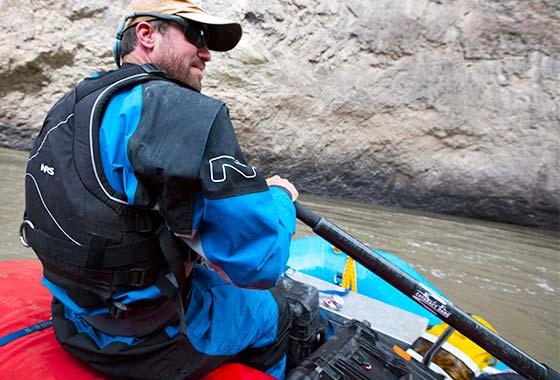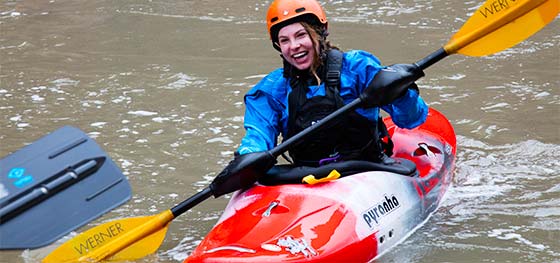Cold Shock: 5 Golden Rules for Boating in Cold Water
by Moulton Avery
Every spring, when paddlers have been cooped up all winter, warm air temperatures lure many into taking small boats out onto lethally cold water. There, an unfortunate number of them capsize or fall in—and drown.
Cold-water immersion is the leading cause of death in paddlesports, yet thousands of paddlers are unaware of the danger. Very few realize that cold shock reaches its most intense level in water temperatures between 50°F and 60°F.

I like to think of cold water as a predator. It’s fast, powerful and deadly, with unlimited energy and no need for sleep. A predator so perfectly camouflaged that you can stand right next to it and see absolutely nothing dangerous, just a sparkling invitation to get out on the water and have some fun.
The victims aren’t stupid, or intentionally reckless, and many are good swimmers. They simply have the misfortune of getting caught in an exceptionally lethal and well-camouflaged trap. Cold water preys on the unsuspecting, the unwary, and the careless, but it also lurks offshore, waiting patiently for those with plenty of experience who don’t take it seriously.
If you’re not wearing thermal protection like a wetsuit or drysuit, immersion in cold water can be immediately life-threatening. The biggest danger is inhaling water and drowning, even if the water is flat, calm and you know how to swim. Cold shock causes an immediate loss of breathing control. You take one or more huge gasps, followed by hyperventilation—very rapid breathing that is hard or impossible for you to control.
If your mouth is underwater when you gasp, you will immediately drown. Many kayakers have been found upside down, still inside their boats, because they died before they could even wet exit. If you paddle on water that’s below 70°F, and particularly if the temperature is 60°F or below, understanding the danger and preparing for it should be your number one safety concern.
Cold-water safety is a hands-on process by which you prepare for the threat of immersion with a combination of equipment, techniques, and planning. To help you with this process, the National Center for Cold Water Safety promotes 5 Golden Rules:
- Always wear your PFD
- Always dress for the water temperature—no exceptions
- Field-test your gear
- Swim-test your gear every time you go out
- Imagine the worst that can happen and plan for it

Each of these rules is important by itself, but it’s the combination of all five that allows you to build a solid cold-water safety net. On the National Center for Cold Water Safety’s website, you’ll find a lot of information and good advice that’s based on scientific and medical research as well as real-life experience. Each Golden Rule, for example, is followed by a number of case histories (there are 20 as of this writing) describing fatal and near-fatal incidents that resulted from breaking a specific rule. Each incident is described in detail along with the lessons learned.
Paddlers can be very creative when coming up with reasons for not following a particular rule. This is particularly true when it comes to Golden Rule No. 2: Always dress for the water temperature. This is why you’ll find the term “no exceptions” attached to it.
Nobody ever expects to capsize and wind up in a life-threatening situation when they go out paddling, but as the saying goes, “$%!+ happens.” The only thing that really matters when your body hits cold water is whether or not you’re prepared for immersion.
Paddlers unexpectedly wind up in cold water thousands of times each year, and the incidents never make the news. That’s because they’re wearing gear that completely eliminates cold shock and delays physical incapacitation and hypothermia.
We don’t hear those stories because, with very few exceptions, nobody gets hurt or even scared. No rescue calls are made, no helicopters are launched, and no search teams get deployed. Of course, the exact opposite happens when a paddler is unprepared for cold water, and the result is often a heart-rending tragedy.
It takes some time and effort to build a solid cold-water safety net. You need the right gear, it has to work properly, and you have to know how to use it. The good news is that it’s not that complicated, anyone can do it, and the safety benefits are enormous.
About the Author:
 Moulton Avery is the founder and director of the National Center for Cold Water Safety. He’s been a key figure in promoting cold water safety for over thirty years, and his pioneering article, “Cold Shock,” appeared in Sea Kayaker Magazine Vol. 7, No. 4, 1991. He gave his first lecture on Accidental Hypothermia in 1974.
Moulton Avery is the founder and director of the National Center for Cold Water Safety. He’s been a key figure in promoting cold water safety for over thirty years, and his pioneering article, “Cold Shock,” appeared in Sea Kayaker Magazine Vol. 7, No. 4, 1991. He gave his first lecture on Accidental Hypothermia in 1974.